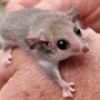It's not the pits

Alexandra Fowler
Today I got to check two different types of pit lines and find a few interesting things even though it was mostly a day of no field work!
Today was Community Day at base camp. No field work was happening. However, some aspects of field work don't pause for the community, pit traps need to be checked every day so that all animals don’t suffer. So before the local school arrived for a look at Bush Blitz and the science happening, I was able to join the vertebrates team to check the trap lines.
Today in the pit traps in the mallee had two more pygmy possums, one male and one female. The male was brought back for further study while the female was released immediately. I got tasked with the release. I took the possum 50m away from the pit line, then hunted down a small tree hollow. It is important to take any animals away from the pit line before the release so that they have a lower chance of being trapped again. Finding hollows in trees are easy, until you need to find one. It took a little while to find a hollow but in the end I found the perfect one. I released the little girl into the hollow and she raced in and curled up.
We went down to the beach for a quick look for a sand slider. One of the other teams had found one there yesterday and released it. It was under the same rock and was collected for further study. We then checked the grasslands pit line where we found a few more spiders, a few bugs and a stone gecko.
On the trip back to base camp we had a little bit of spare time so we when for a quick hunt around a dilapidated shed. This site had a few good hiding spots under tin sheets, old chunks of concrete and rocks. Although nothing popped up under things, there was an empty concrete open top tank where a large spider was hanging out. One of the team reached in with a stick to fish the spider out. He was a great specimen to bring back.
The Penong School came for a visit to base camp and the scientists all set up little displays. It was very interesting to listen in and look at all the different samples, specimens and displays.
In the afternoon I went with the Invertebrates Team to check their pit line. The pit line was set up on the salt flats. This pit line used much smaller traps which were filled with Propylene Glycol which preserves the insect and spider specimens instantly. The smaller traps mean that things like mammals and reptiles don’t get trapped by them. We found a few tiny spiders in these traps and a couple of tiger beetles. Before we headed back to base camp we had a little scout around some mallee habitat where I found a moth cocoon and a spider.
I have found this trip absolutely amazing and am so sad to be heading home. The scientists have been really approachable and have taught me so much!

